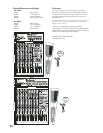
16
46. STEREO AUX RETURN Inputs
Connect the outputs of an external parallel eff ects
device into these inputs.
When connecting a mono device (just one cord),
always use the left (mono) input and plug nothing into
the right input. The signal will appear on both sides.
The signal is added directly into the main mix (or
Sub 1-2 bus on the Mix.260FX when the MAIN/SUB
1-2 switch [31] is pushed in) via the Master AUX
RETURN level control [30].
47. STEREO FX RETURN Inputs
Connect the outputs of an external parallel eff ects
device into these inputs.
Plugging a 1/4" plug into these jacks disconnects
the Internal Eff ects processor. Note that if you plug
into just the left input, the right internal eff ects is
still connected, and vice versa. This gives you the
fl exibility to create some very unusual eff ects.
The signal is added directly into the main mix via
the Master FX RETURN level control [32].
48. 1/4" MAIN OUT (Mix.260FX only)
These 1/4" TRS jacks provide a balanced or
unbalanced line-level signal,
where your fully mixed
stereo signal enters the real world. This is the same
signal that appears at the XLR MAIN OUTS [52] on
the rear panel.
Connect these outputs to the inputs of your
amplifi ers, powered speakers, or serial eff ects
processor (graphic equalizer, for example).
49. CD/TAPE IN/OUT
TAPE OUTPUTS
Use these jacks to capture the entire performance
to
tape. The signal at these jacks is a sample of the
main mix, as it appears at the MAIN [52] output. The
TAPE OUTPUT level is aff ected by the MAIN MIX
[42] faders.
TAPE INPUTS
This is where you connect the outputs of your
intermission entertainment. Any line-level mono or
stereo device can be used, such as tape, DVD/CD
player, television audio, etc.
Signals coming into these inputs are routed
directly to the main mix when the TAPE TO MAIN
[24] switch is pushed in. The signals can also be
routed to the CONTROL ROOM [55] and PHONES
[50] outputs when the CD/TAPE [21] switch is
engaged in the CONTROL ROOM SOURCE
SELECT section.
When connecting a mono device (just one cord),
you’ll need a “Y-splitter” RCA adapter. It turns a
mono output cord into two cords, so both the right
and left tape input jacks can be used. This adapter is
widely available.
Note: There is a chance of feedback if you have
the tape inputs and outputs connected to the same
recorder, and the recorder is in record mode.
50. PHONES
The stereo signal at this output jack is the same as
the CTRL RM OUTS [55] outputs, and is controlled
by the same CTRL ROOM/PHONES level control
knob [23]. You can listen to the Main Mix, the
CD/TAPE, or the ALT 3-4 (Mix.220FX) or SUB 1-2
(Mix.260FX) depending upon the CONTROL ROOM
SOURCE SELECT switches.
Note: Be very careful because the PHONES jack
can drive any standard headphones to very loud
levels. Please see page 2 for information on hearing
protection.
51. FOOTSW
This 1/4
"
TS jack allows you to connect a standard
footswitch for engaging the Internal FX BYPASS [38]
function. Note that the indicator light next to the FX
BYPASS switch illuminates when the bypass function
is engaged.
REAR PANEL FEATURES
52. XLR MAIN OUTS
These male XLR connectors provide a balanced
line-level signal that represent the end of the mixer
chain, where your fully mixed stereo signal enters the
real world. Connect these to the inputs of your main
power amplifi ers, powered speakers, or serial eff ects
processor (like a graphic equalizer or compressor/
limiter).
53. ALT 3/4 OUTS (Mix.220FX)
These 1/4
" TRS jacks provide the outputs for the
ALT 3 and 4 signals. These can be connected to the
inputs of a recording device, or to secondary amplifi ers
for an alternate mix.
POWER
POWER
PHANTOM
PHANTOM
48V
48V
PHONES FOOTSW
MAIN OUT
OUT
L
R
AUX RETURN
RETURN
1
MON
MON
2
FX
FX
L
L
FX RETURN
RETURN
AUX SEND
SEND
RR
(MON0
MON0
)
INPU
INPU
T/OUTPU
T/OUTPU
T
IN
IN
OUT
OUT
L
R
CD/TAPE
45 47
50
46
48
49
51
43
44


















